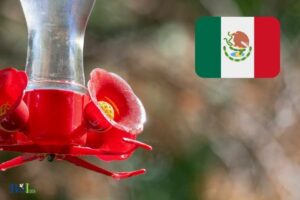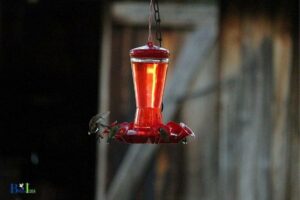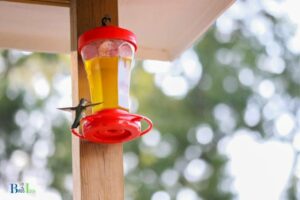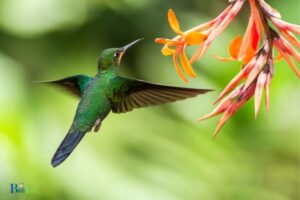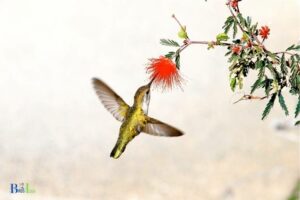Glass Vs Plastic Hummingbird Feeders: Which One Is Better?
When comparing glass and plastic hummingbird feeders, glass feeders are generally more durable and attractive, while plastic feeders are cheaper and lightweight.
Hummingbird feeders are popular garden accessories designed to attract the tiny, fast-flying birds.
They come in various materials, with glass and plastic being the most common.
Glass feeders, often hand-blown and intricately designed, can add a touch of elegance to your garden.
They’re often more durable and weather-resistant, too.
When deciding between glass and plastic hummingbird feeders, consider factors such as durability, aesthetics, price, and maintenance.
Glass feeders are a more long-lasting and attractive option, while plastic feeders are a budget-friendly and easy-to-use alternative.
Ultimately, the choice depends on personal preferences and priorities.
8 Features About Glass Vs Plastic Hummingbird Feeders
| Feature | Glass Hummingbird Feeders | Plastic Hummingbird Feeders |
|---|---|---|
| Durability | More durable, longer-lasting | Less durable, may crack or fade over time |
| Weight | Heavier, more stable | Lighter, easier to hang and handle |
| Aesthetic Appeal | Often more attractive and decorative | Simpler designs, may lack visual appeal |
| Ease of Cleaning | Can be more difficult to clean due to narrow openings | Easier to disassemble and clean |
| Cost | Generally more expensive | More affordable, budget-friendly option |
| UV Resistance | Better resistance to UV damage | May become brittle or discolored with sun exposure |
| Safety for Birds | Less likely to leach harmful chemicals | Some plastics may leach chemicals if low quality |
| Temperature Resistance | Better resistance to temperature fluctuations | May warp or crack in extreme temperatures |
Key Takeaway
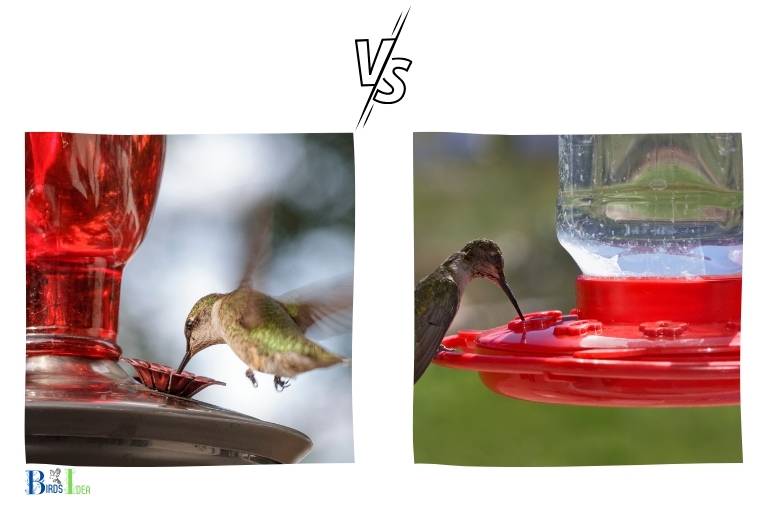
Five Facts About: Glass and Plastic Hummingbird Feeders
What are the Benefits of Using a Glass Hummingbird Feeder?
Using a glass hummingbird feeder has several distinct advantages over plastic feeders. These feeders not only offer a touch of elegance and style to your garden but are also more durable and valuable for the environment.
Here are some key benefits of using a glass feeder:
- Durability: Glass feeders are resilient against weather changes and tend to last longer than plastic ones, which may become brittle and break down over time.
- Eco-friendliness: Glass is a sustainable and recyclable material, making it an environmentally-friendly choice to help reduce waste.
- Aesthetic appeal: Glass hummingbird feeders often come in a variety of designs and colors, adding a beautiful and eye-catching element to your garden.
- Easy to clean: Glass is a non-porous material, making it easier to clean and maintain than plastic ones, which can develop harmful mold and bacteria over time.
- UV resistance: Unlike plastic, glass does not degrade or become discolored under the sun’s ultraviolet rays, ensuring the nectar remains fresh and safe for the hummingbirds to consume.
“Glass feeders are durable and easy to clean, making them a healthier option for your hummingbirds.”
birdsidea
What are the Benefits of Using a Plastic Hummingbird Feeder?
The benefits of using a plastic hummingbird feeder are numerous, making them an excellent alternative to glass feeders for attracting these fascinating little birds to your garden.
Plastic feeders offer several advantages, including:
- Durability: Plastic feeders are less likely to break or crack compared to their glass counterparts, ensuring they last for multiple seasons.
- Lightweight: The lightweight nature of plastic feeders makes them easy to hang, move, and clean without added strain.
- Variety: Plastic hummingbird feeders come in various colors, shapes, and sizes, providing a wide range of options for birdwatchers to choose from.
- Price: Generally, plastic feeders are more affordable than glass ones, making them accessible for individuals with various budgets.
- Safety: Since plastic feeders are less likely to shatter, they pose a lower risk of injury to both humans and birds.
How to Choose the Right Hummingbird Feeder: Glass Versus Plastic?
Choosing the right hummingbird feeder can significantly impact your bird-watching experience.
When deciding between glass and plastic hummingbird feeders, there are several factors to consider that will help you find the perfect match for your needs.
- Material: Glass hummingbird feeders tend to be more durable and aesthetically pleasing than plastic feeders. However, they may be heavier and more prone to breakage.
- Maintenance: Both glass and plastic feeders require regular cleaning to prevent mold and bacteria growth. Glass feeders are generally easier to clean thoroughly, while plastic may be prone to staining and harder-to-reach crevices.
- Capacity: Consider the number of hummingbirds you expect to attract and choose a feeder with an appropriate capacity.
- Price: Glass feeders tend to be more expensive due to their material cost and craftsmanship. However, plastic feeders are more budget-friendly and more easily replaced if damaged.
In conclusion, weigh the pros and cons of glass and plastic hummingbird feeders based on durability, maintenance, capacity, and price.
Ultimately, the right choice will depend on your personal preferences and requirements for your bird-watching experience.
Pro tip: No matter which type of feeder you choose, ensure it has proper ventilation and easy access for hummingbirds to feed.
birdsidea
Are Glass Hummingbird Feeders More Attractive Than Plastic?
When considering the attractiveness of glass versus plastic hummingbird feeders, factors such as design, durability, and bird preference come into play.
While both types can be visually appealing, glass feeders often offer more intricate designs and vibrant colors that may be more attractive to hummingbirds.
Additionally, glass feeders are typically more durable and easier to clean than plastic ones, which ensures a better feeding experience for these delicate creatures.
Is a Plastic Hummingbird Feeder Easier to Clean Than a Glass Feeder?
A plastic hummingbird feeder can be easier to clean than a glass feeder for several reasons, including its lightweight design and typically simpler construction.
Many plastic feeders are also dishwasher-safe, making cleaning more convenient. However, glass feeders offer other benefits, such as being less prone to discoloration and being more durable overall.
When comparing the two types, it’s important to consider factors like ease of cleaning, durability, and aesthetic preferences to determine the best option for your needs.
Ease of cleaning plastic hummingbird feeders:
- Lightweight and easy to handle
- Often dishwasher-safe
- Simpler construction with fewer parts to clean
Ease of cleaning glass hummingbird feeders:
- May require hand washing
- Typically more intricate design with more parts
- Heavier and more fragile
In conclusion, while plastic hummingbird feeders might be easier to clean, it’s essential to consider other factors, such as durability and aesthetics, before deciding which type best suits your needs.
Regardless of the feeder material, proper cleaning and maintenance are crucial to ensure a safe feeding experience for the hummingbirds.
Tips for Maintaining and Cleaning a Glass Hummingbird Feeder
Maintaining and cleaning a glass hummingbird feeder is essential for ensuring a healthy environment for the birds, as well as prolonging the life of the feeder.
Glass feeders offer benefits such as durability, resistance to discoloration, and a more sanitary feeding environment compared to plastic feeders.
- Clean the feeder regularly: Aim to clean the feeder at least once a week, or more frequently in hot weather, to prevent mold and bacterial growth.
- Use the right tools: A long, flexible brush designed for cleaning bird feeders will help you reach all the nooks and crannies.
- Use a mild cleaning solution: Mix equal parts water and white vinegar to clean the feeder without using harsh chemicals that can stress the birds.
- Rinse thoroughly: After cleaning, be sure to rinse the feeder thoroughly with warm water to remove any residue before refilling with nectar.
- Avoid soap residue: If you use dish soap in the cleaning process, make sure to rinse the feeder very well, as soap residue can be harmful to hummingbirds.
- Replace nectar regularly: Change the nectar every three to five days, or more frequently in hot weather, to keep it fresh and prevent fermentation or spoilage.
- Inspect for cracks or damage: While glass feeders are more durable than plastic, they can still crack or break. Regularly inspect your feeder for damage and replace it if necessary.
Pro Tip: To deter ants and other insects from invading your hummingbird feeder, consider using an ant guard, which can be hung above the feeder and filled with water to create a barrier that insects cannot cross.
birdsidea
According to a study by the University of Maine, ants are less attractive to glass feeders because they cannot climb the slippery surface of the glass.
birdsidea
Are glass hummingbird feeders better than plastic?
Hummingbird enthusiasts often debate whether glass or plastic feeders make a better choice for their feathered friends.
Both materials have their pros and cons, so it can be challenging to determine which is best. Glass feeders are what many people traditionally think of when they picture a hummingbird feeder.
In contrast, plastic feeders are a newer invention that has become popular in recent years. The decision between the two ultimately comes down to personal preference and the type of environment in which you live.
- Glass feeders are durable and can last for many years if properly cared for.
- Plastic feeders are lightweight and more affordable than glass feeders.
- Glass feeders can be more aesthetically pleasing and come in various designs.
- Plastic feeders are easier to clean and maintain than glass feeders.
- Glass feeders are better for the environment because they are recyclable, whereas plastic feeders contribute to plastic waste.
- Plastic feeders can be more practical in windy environments since they are less likely to break if they fall.
They are the only bird species that can do so, thanks to their unique wing structure.
Additionally, hummingbirds have a surprisingly fast heartbeat, with some species having a heart rate of up to 1,260 beats per minute.
Providing them with a source of nutritious nectar from a glass or plastic feeder can help them maintain their high metabolism and stay healthy.
Is glass or plastic better for a hummingbird feeder?
When it comes to hummingbird feeders, one of the questions that may crop up is whether to use glass or plastic. Both have their pros and cons, which we’ll discuss below.
Pros and cons of glass hummingbird feeders:
- Pros: Glass feeders are more aesthetically pleasing, less likely to discolor or scratch, and provide a more natural look in your garden.
- Cons: Glass feeders are heavier and more fragile, which makes them more challenging to hang and could break easily if knocked over.
Pros and cons of plastic hummingbird feeders:
- Pros: Plastic feeders are lightweight, durable, and less likely to break if dropped. They are also less expensive and come in a more extensive range of styles and colors than glass feeders.
- Cons: Plastic feeders can fade and discolor depending on the quality of the plastic, and they may not have the same visual appeal as glass feeders.
Ultimately, whether to use a glass or plastic hummingbird feeder is a personal preference. However, keep in mind that hummingbirds do not have a preference for either material.
Additional tips for choosing a hummingbird feeder:
- Choose a feeder with bright colors to attract hummingbirds.
- Look for a feeder that is easy to clean and refill.
- Hang your feeder in a location with ample shade and protection from wind and rain.
Hummingbirds can fly at speeds of up to 60mph!
What is best for hummingbird feeder?
Hummingbirds bring a wonderful sight and sound to any garden or yard. To attract these magnificent creatures, many people use hummingbird feeders.
However, choosing the right type of feeder can be confusing. So, what is best for hummingbird feeder? Glass or plastic?
Let’s take a closer look and compare the two options to help you decide which one is suitable for your needs.
Here are some key factors to consider when deciding on the material of your hummingbird feeder:
- Durability: Glass feeders are more fragile and can crack or break easily. Plastic feeders, on the other hand, are sturdier and can last for years without breaking.
- Maintenance: Glass feeders are easier to clean and don’t scratch as easily as plastic feeders. Plastic feeders can develop scratches over time, which can harbor bacteria.
- UV damage: Plastic feeders can be damaged by the sun’s UV rays, causing them to fade and become brittle. Glass feeders are not affected by the sun.
- Aesthetics: Glass feeders are often more attractive and look more elegant than plastic feeders.
Overall, the decision between a glass or plastic hummingbird feeder comes down to personal preferences, budget, and maintenance.
If you are looking for a durable and low-maintenance option, a plastic feeder might be the best choice. But, if you want a feeder that is easy to clean and looks beautiful, a glass one is a great option.
- Make sure to choose a feeder that is easy to clean and refill.
- Consider the size of the feeder and how much nectar it can hold.
- Look for feeders with bee guards to keep bees away from the nectar.
- Hang your feeder in a shaded area to prevent the nectar from spoiling quickly.
Hummingbirds have the highest metabolism of any bird species, with a heart rate that can reach up to 1,200 beats per minute.
What is the best material for bird feeder?
Choosing the right material for your bird feeder can make a big difference in attracting birds to your yard. While there are various options available, each has its own set of advantages and disadvantages.
Some common materials include wood, metal, plastic, and glass.
Wooden feeders are a natural and attractive choice that can last for years, but they are susceptible to weather damage and require regular maintenance.
Metal feeders are durable and weather-resistant, but they can also be prone to rust and can get hot in the sun.
Plastic feeders are lightweight and affordable, but they may not be as durable as other materials and can become brittle over time.
Glass feeders are a visually appealing choice that is easy to clean, but they can be fragile and can break easily in extreme weather conditions.
Ultimately, the best material for your bird feeder will depend on your personal preference and the kinds of birds you want to attract.
Consider factors such as durability, maintenance requirements, aesthetic appeal, and your budget when selecting the right material for your bird feeder.
Factors to consider when choosing a material for your bird feeder:
- Durability
- Maintenance requirements
- Aesthetic appeal
- Budget
- Types of birds you want to attract
Are Plastic Bird Feeders Good?
When it comes to bird feeders, there are various types, sizes, and materials to choose from. Plastic bird feeders are a popular option due to their affordability, durability, and availability in a range of designs.
But are they good for the birds? While plastic bird feeders have their advantages, they also have some drawbacks to consider.
Advantages of Plastic Bird Feeders:
- Affordable compared to other materials
- Durable and long-lasting
- Available in a range of designs, sizes, and colors
Drawbacks of Plastic Bird Feeders:
- Can deteriorate in sunlight and extreme weather conditions
- Can develop cracks, which can harbor bacteria and fungus
- Can be easily damaged by squirrels and other animals
In conclusion, plastic bird feeders can be a decent choice for bird enthusiasts on a budget. However, it’s crucial to inspect them regularly for any damage, clean them thoroughly, and avoid exposing them to harsh weather conditions.
Investing in high-quality plastic bird feeders that are specially designed to withstand weather changes and critter intrusions can also be a viable option.
Place plastic bird feeders at a reasonable height and distance from trees or bushes to prevent squirrels from jumping onto them.
FAQ for Glass Vs Plastic Hummingbird Feeders
What are the advantages of glass vs plastic hummingbird feeders?
Glass feeders often keep nectar fresher longer than plastic feeders and more easily cleaned, since plastic can retain bacteria and algae that can spoil nectar. Glass is also considered a more attractive material than plastic.
Are plastic hummingbird feeders less expensive than glass feeders?
Is it easier to maintain a plastic or glass hummingbird feeder?
Is one type of feeder more likely to attract hummingbirds than the other?
Conclusion
In conclusion, both glass and plastic hummingbird feeders have their advantages and disadvantages.
Glass is more attractive and durable, but can break and requires more careful cleaning. Plastic is lighter, easier to clean, and less expensive, but may fade or crack over time.
When choosing a hummingbird feeder, consider factors such as durability, attractiveness, ease of cleaning, and budget.
No matter which type of feeder you choose, remember to keep it clean and filled with fresh nectar to attract and nourish hummingbirds throughout the season.


